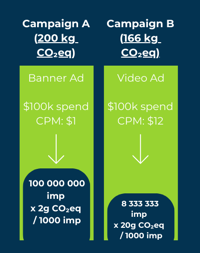Fix this 1 subtle mistake for more impact reducing ad emissions

Opinion
Ahead of Cop28, are we using the right KPIs to reduce our digital advertising emissions, asks Impact+’s co-founder.
Online marketers can be forgiven for feeling little overwhelmed when trying to reduce our industry’s oversized carbon footprint.
Despite the steady progress made by the digital ecosystem over the last two years in acknowledging the impact it has on the environment, there is still a long, long way to go.With its growth powering everything from the rise in retail media to CTV platforms, emissions have ballooned in recent years, making it one of the fastest growing sources of greenhouse gas (GHG) emissions.
So, as we head towards the UN’s 28th Climate Change conference (or Cop28) at the end of the month, digital marketers have no choice but to tackle its growing impact on the planet head on.
Rather than be cowed by the eye-watering numbers facing them, this is an opportunity for media owners and advertisers to make a lasting difference.
But where do they even start?
Fix this mistake when measuring emissions
Like any task, it’s important to start with the basics, including setting the right success metrics.
That may seem obvious, but with the industry still getting to grips with the best way to measure its impact on the environment and emissions, establishing best practices is far from straightforward.
It means digital marketers must be careful to avoid adopting processes that have the opposite effect of what they’re aiming for.
One example of this is making sure to set the right environmental KPIs.
Many of the KPIs being used today focus on measuring carbon-dioxide emissions (CO2e) per 1,000 impressions. However, a much better way a brand can reduce the impact of its digital ad spend is by measuring CO2e per £1,000 spent instead.
Let me show you what I mean with using today’s Black Friday as an example.
Why impressions can be misleading
Imagine you are running two digital ad campaigns — let’s call them Campaign A and Campaign B — both have the same budget of £100,000.
Campaign A is a Black Friday banner campaign with relatively small file sizes, while Campaign B is a Christmas ad that includes videos with large file sizes. In both campaigns, you’ve focused on optimising for GHG per 1,000 impressions, a KPI currently widely used across the industry.
Based on the formats themselves, you’d expect the banner ads to generate about 2g CO₂eq per 1,000 impressions, whereas the video ads should generate around 10 times that.
But after blowing both budgets in the first two weeks, you notice Campaign A is generating more emissions.

While the greenhouse gas emissions per 1,000 impressions metric is as expected (Campaign A is lower than Campaign B), Campaign A’s total emissions (measured in kilograms of CO₂eq emitted) is at 200 kg CO2eq, whereas Campaign B has emitted 166 kg CO₂eq.
In the example (left), the higher total emissions from Campaign A are a result of its lower CPM, which means more impressions were delivered than Campaign B, for the same amount of money.
Campaign B had fewer impressions than A, which meant, even though its video formats emitted more per individual impression, the total emissions were lower.
That’s because, while here’s a tendency to concentrate on GHG emissions per 1,000 impressions when tracking the environmental impact of their digital ads, it can be misleading.
Instead, it’s better to use the GHG emissions per 1000€/$/£ spent metric across all your campaigns.
Tools for the long-term
This unit-level metric — as well as measuring the total volume of emissions across all their campaigns — will provide marketers with the tools they need to accurately gauge the long-term environmental impact of their online advertising.
This means advertisers will be better placed to take decisions with the right levers to drive reduction across their spend.
So, while it’s easy to feel daunted by the size of the task ahead, the digital ad industry is better placed than most to do something about it.
So, let’s get started.

Audrey Danthony is chief Product Officer and co-founder of global sustaintech platform Impact+




